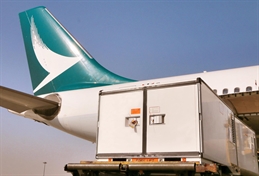CATHAY NOTES VOLUME SLOWDOWN IN BANGLADESH, SRI LANKA BUT SAYS SOUTH ASIA RECOVERY UNDERWAY
Cathay Pacific noted the ongoing recovery of the aviation sector in South Asia as the region has fully reopened, although production in some key manufacturing hubs has slowed due to more muted demand.
In a market update, Rajesh Menon, regional head of cargo, SAMEA ( South Asia, Middle East, Africa) said the region is now seeing a "new normal" in which COVID-19 forced positive changes in both adaptability and agility, and also a welcome transition to digital platforms and the ways in which cargo is booked and paid for across the subcontinent.
"Currently, we're welcoming back more passenger services across our region as Cathay Pacific rebuilds its network, but it's worth remembering that air cargo and our operations never actually stopped over the past couple of years," Menon said, although noting changes that happened to the industry.
"As we lost the ability to run so many long-haul freighters on transpacific routes, we had to focus more on the Asian market where there was still cargo capacity from our regional freighters. In fact, as a consequence of temporarily losing the capacity to the Americas earlier this year, we were able to add about 15% to Asian tonnages – and this will be retained as a core market for us in future," he added.
The Cathay SAMEA chief noted that with the resumption of passenger services to Dubai and Bengaluru, customers have more options and more access to the Americas via our transpacific freighters.
Cathay said some of these reintroduced passenger flights will replace operations that ran throughout the pandemic period, such as the weekly cargo-only passenger service to Kathmandu, and another will run in addition to the freighter that served Bangladesh throughout the pandemic.
The return of passenger flights in Europe also boosted tonnage growth there, and we hope that more choices will lead to a similar bounce here.
"What else has changed? The pandemic required us to become more adept and agile," Menon said.
He added that the other major change here has been how quickly the market has adapted to work around the restrictions.
In India, Menon noted that because of its large and young IT workforce, the country has been one of the biggest markets to make the jump to digital platforms.
It added that now 90% of the bookings at our ports come via Click & Ship. The use of a cash payment for cargo clearance payable at airports has also evolved.
Lower production amid global economic risks
"In terms of the market, we were fully open across South Asia with normal levels of manufacturing and the normal appetite for consumption by the start of this year.," Menon said.
"We are seeing some slowdown in production in Bangladesh and Sri Lanka: ordinarily, we see orders placed by garment manufacturers in September for export at Christmas, but those are down because of falling consumer confidence in the US and Europe," he said.
The Cathay executive said the market remains robust, in part because of its consumption model fuelled by India, which will keep imports high, and we will be able to fill our additional capacity.
Meanwhile, Mennon added that while there may be a marginal decline in exports from India in the near term, we see this recovering with some growth by the middle of 2023.




